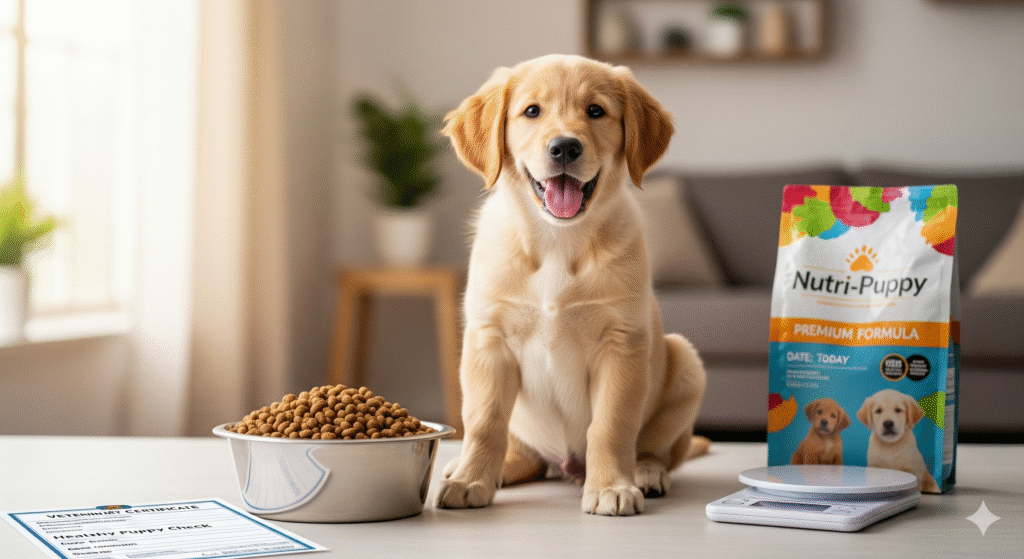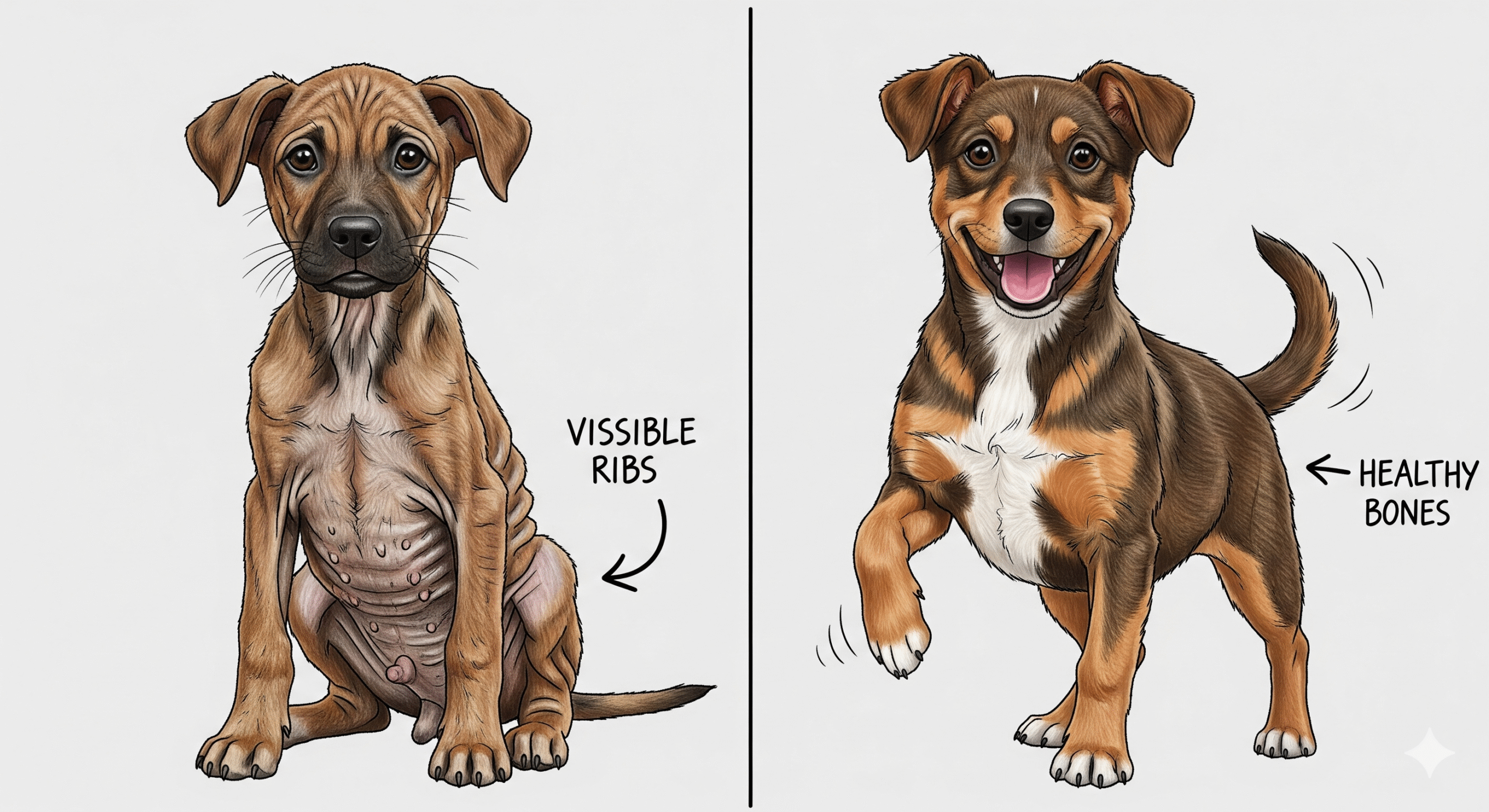Noticing that your puppy is too thin can be a heart-dropping moment for any pet parent. Whether you’ve welcomed a rescue who had a rough start or your own pup seems to be falling behind, helping an underweight puppy gain weight is a delicate process that requires knowledge, patience, and care. 🥰
It’s not just about feeding them more; it’s about feeding them right and ensuring there’s no underlying medical issue. This comprehensive guide will walk you through the signs of an underweight puppy, the potential causes, and most importantly, vet-approved strategies for healthy weight gain. Remember, your first and most important step is always a visit to the veterinarian to rule out serious health problems.
Is My Puppy Underweight? How to Tell 🤔
Puppies grow at an astonishing rate, and their ideal weight varies drastically by breed. Simply looking at them isn’t always enough. Here’s how to perform a simple Body Condition Score (BCS) test at home:
- Rib Check: Run your hands along your puppy’s sides. You should be able to feel their ribs easily under a thin layer of fat. If the ribs are sharply defined with no fat cover and visible from a distance, your puppy is likely underweight.
- Top-Down View: Look at your puppy from above. You should see a defined waist behind the ribs. If the waist is severely exaggerated and the hip bones are prominent, this is a sign of being underweight.
- Side View: Look at your puppy from the side. The abdomen should be tucked up, but not extremely so. A severely tucked abdomen (like a greyhound) can indicate being underweight.
Expert Insight: “The ‘rib test’ is the gold standard for owners. You should be able to feel the ribs like the back of your hand, not see them like a washboard. If you see sharp ribs, spine, and hip bones, it’s time for a vet visit and nutritional intervention.” – Dr. Sarah Mitchell, DVM
Why is My Puppy Underweight? Common Causes 🔍
Understanding the root cause is critical to formulating the right solution. Causes can be behavioral, environmental, or medical.
- Parasites: This is a HUGE one for puppies. Intestinal worms (like roundworms, hookworms, whipworms) steal vital nutrients from your puppy’s food before their body can absorb them.
- Inadequate Caloric Intake: Simply not eating enough high-quality food for their growth rate and energy needs.
- Underlying Illness: Conditions like infections, liver shunts, exocrine pancreatic insufficiency (EPI), or congenital problems can prevent proper nutrient absorption.
- Dental Issues: Pain from teething or other dental problems can make a puppy reluctant to eat.
- Stress or Anxiety: A new environment, bullying from other pets, or general anxiety can suppress appetite.
- High Energy Burn: Exceptionally active puppies may simply burn more calories than they consume.
Step 1: The Non-Negotiable Veterinary Visit 🩺
Before you change a single thing about your puppy’s diet, you must schedule a vet appointment. This is crucial to:
- Rule out parasites (via a fecal exam).
- Diagnose or rule out any underlying medical conditions.
- Get a professional assessment of your puppy’s ideal target weight.
- Receive tailored advice for your puppy’s specific breed, age, and health status.
Do not skip this step. Well-meaning but incorrect feeding can cause more harm than good.
Choosing the Right Food for Healthy Weight Gain 🍗
Not all puppy foods are created equal when it comes to helping a puppy gain weight. You need a calorie-dense, highly digestible, and nutrient-rich formula.
- Look for High-Quality Protein: The first ingredient should be a named animal protein (e.g., chicken, salmon, lamb). Protein is essential for building muscle mass, not just fat.
- High Fat Content: Fat is calorie-dense, providing more energy per gram than protein or carbohydrates. Look for formulas with a fat content of around 18-20% or higher.
- “Puppy” or “Performance” Formulas: These are specifically designed for growth and are more calorie-dense than adult maintenance formulas.
- Consider Wet Food: Canned food is often more palatable and has a higher fat content than kibble, which can encourage eating.
Our Top Food Choices for an Underweight Puppy
- Royal Canin Veterinary Diet Gastrointestinal Puppy: Often recommended by vets for pups needing easy digestion and weight gain. (Requires a prescription).
- Hill’s Science Diet Puppy Healthy Development: A highly digestible, balanced option available over-the-counter.
- Purina Pro Plan Puppy Sport: Formulated for highly active dogs, making it excellent for calorie-dense nutrition.
How to Safely Increase Caloric Intake 🍽️
Once your vet gives the all-clear, you can implement these strategies:
- Feed More Frequently: Instead of two large meals, offer three or four smaller meals throughout the day. This is easier on their digestion and helps maintain energy levels.
- Add Appetizing Toppers: Make their regular kibble more enticing.
- A tablespoon of plain, cooked chicken or turkey.
- A teaspoon of plain pumpkin puree (not pie filling).
- A splash of warm water or low-sodium chicken broth to soften the kibble and enhance the smell.
- Consider a Temporary Switch: Mixing in a high-quality wet puppy food with their kibble can significantly increase calorie intake and palatability.
What to Avoid When Helping a Puppy Gain Weight ⚠️
In your desire to help, it’s easy to make mistakes. Never do the following:
- Feed Human Food: Especially avoid fatty meats, gravy, and table scraps. This can cause severe pancreatitis, a painful and dangerous illness.
- Overfeed Dramatically: Sudden, large increases in food can cause diarrhea and stomach upset, setting back progress.
- Create a Picky Eater: While toppers are great, don’t fall into the trap of offering 10 different things until they eat. Stick to one or two reliable mix-ins.
Monitoring Progress: The Weekly Weigh-In 📊
Tracking progress is essential to ensure your plan is working.
- Weigh your puppy at the same time each week (e.g., every Saturday morning before breakfast).
- Use the same scale each time.
- Keep a simple log: Date -> Weight -> Notes (e.g., “energy levels good,” “stool normal”).
- Gradual weight gain is the goal. Rapid weight gain is unhealthy and hard on a puppy’s developing system.
When Weight Gain Doesn’t Happen: Red Flags 🚩
If you are following your vet’s advice and your puppy is still not gaining weight, or is even losing weight, it’s time to go back to the vet. Other red flags include:
- Lethargy or low energy
- Vomiting or persistent diarrhea
- A distended or bloated belly
- Signs of pain or discomfort
These could indicate a more serious underlying condition that requires advanced diagnostics.
The Journey to a Healthy Weight ❤️
Helping an underweight puppy thrive is one of the most rewarding experiences. It requires a partnership with your veterinarian, patience, and consistent, loving care. By focusing on high-quality nutrition, strategic feeding, and close monitoring, you can give your puppy the best possible start for a long, healthy, and happy life.
Have you helped an underweight puppy before? What was your biggest challenge or most successful tip? Share your experience in the comments to help other pet parents on this journey! 👇

“Determining the right amount of food for your puppy isn’t a static process; their nutritional needs change dramatically as they grow. Portions must be adjusted based on their current weight, age, and expected adult size. The most accurate way to ensure you’re feeding the correct amount is to regularly weigh your puppy and track their progress against established benchmarks. This prevents overfeeding, which can cause joint problems in large breeds, or underfeeding, which can stunt growth. To find these benchmarks and see if your puppy is on the right track, refer to our comprehensive Puppy Growth Chart: Weight Expectations for guidance.”






